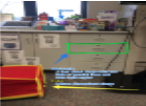
Look Closer! It’s Geometry in Action!

Overview
It starts with the snapping of pictures in everyday objects within the classroom and beyond! Then, with an even closer look, students use Skitch an iOS app to enhance their photos to identify geometric vocabulary terms found in our daily lives.
This activity will take several class periods for the students to learn Skitch and apply it.
Learning Objectives
Students will:
- Be able to identify geometric vocabulary terms found in everyday objects.
- Be able to use the Skitch iOS app to label, highlight and enhance their photos.
Vocabulary
Vocabulary Words:
-
Camera Roll: A camera roll is a place on the iPad where pictures are stored.
-
Crop: Crop is an edit feature in the camera roll and Skitch to eliminate unwanted parts of a picture.
Pre-planning
To prepare for this lesson:
-
The teacher will list the geometric terms students have learned and will be identifying.
-
Watch the video tutorial on how to use Skitch.
-
Teach students to use Skitch by doing the following:
- Have students take a picture of an object in the room and save to the Camera Roll.
- Open the app.
- Hit the X to get out of the tutorial.
- Allow Access to Camera and Camera Roll.
- Slide the words across the bottom to Photos and tap on the photo of their friend.
- Tap on the white arrow to see all of the tools available.
- To undo hit the arrow at the top of the screen.
- To crop out any unwanted areas, hit the square at the top of the screen.
- Experiment with text by typing the name of the object, then dragging to bottom.
- Continue to experiment with the drawing tool and arrows.
- To change colors tap the colored circle on the left.
- When complete, tap the box with the arrow popping out in the right upper corner.
- Slide across the bottom to Save and tap Photos.
Accommodations
See the Accommodations Page and Charts on the 21things4students website in the Teacher Resources.
Steps
Directions for this activity:
- Review the geometry vocabulary taught in the unit. List the terms on the board and give them a minimum number of terms to find.
- Allow students to take several (five-seven) pictures on their iPads of the classroom, playground or within the school building. Pictures should be saved to their Camera Roll.
- Open the Skitch app on the device.
- Slide the words across the bottom to Photos and tap on one of the photos recently taken.
- If needed, crop out any unwanted areas by hitting the square at the top of the screen.
- To define shapes, lines or angles: Tap on the white arrow, click on the marker.
- Tap the color button to pick a color and drag their finger along the lines of a shape or an angle.
- Tap on the white arrow again and hit the text button to label the shape or angle.
- When complete, tap the box with the arrow popping out in the right upper corner
- Slide across the bottom to Save and tap Photos.
- From here, it can be put into Seesaw, Apple Classroom, Google Classroom, Docs or Slides. It can be uploaded to Seesaw.
- Repeat steps with other photos until all terms that have been listed (or minimum) identified.
Example:

Assessment Options
Different options for assessing the students:
- Observations
- Check for understanding
- Students may turn in work via Seesaw, Google Classroom, Google Slides or Docs, Apple Classroom or email.
- Ways to assess:
- Identified minimum amount of vocabulary terms required correctly.
- Observation for mastery or reteaching.
MITECS Competencies & ISTE STANDARDS
MITECS: Michigan adopted the "ISTE Standards for Students" called MITECS (Michigan Integrated Technology Competencies for Students) in 2018.
Knowledge Constructor
3c. Students curate information from digital resources using a variety of tools and methods to create collections of artifacts that demonstrate meaningful connections or conclusions.
Devices and Resources
App:
Skitch iOS
Website:
Skitch Video Tutorial
CONTENT AREA RESOURCES
ELA
Have students identify character traits of characters in fiction books by taking a picture of the main character and labeling the photo with the traits and examples.

Integrated Arts
Physical education: Students can take pictures of friends engaging in basketball or baseball skills to highlight the correct formation of arms and legs.
Math
Students can take pictures of long division or multiplication problems to fill in missing numbers, step by step instructions or lable the vocabulary terms, such as divisor.
Science
Students can use their photos to document experiments, such as plant parts, states of matter and erosion.
CREDITS
This task card was created by Mary Ledford, Saline Area Schools, April 2018. Updated October 2023.


